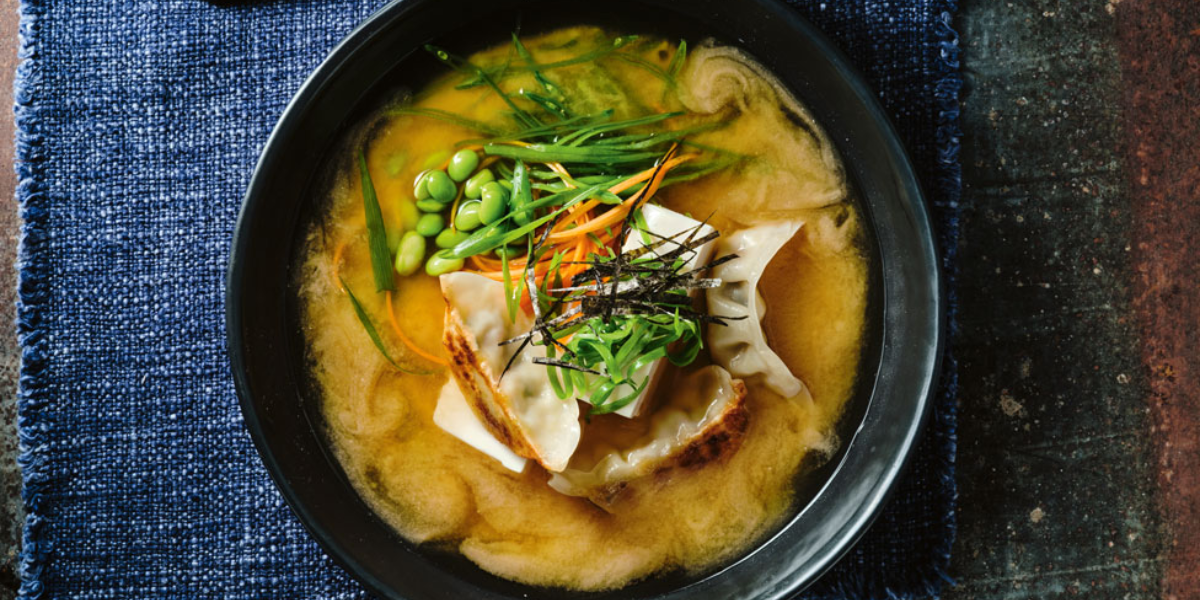Introduction:
Miso soup is a cornerstone of Japanese delicacies, loved for its comforting warm temperature and rich umami taste. This conventional soup, crafted from miso paste and dashi broth, frequently consists of additives collectively with tofu, seaweed, and green onions. Its simplicity, dietary benefits, and intensity of flavor make it a loved dish each in Japan and spherical the region.
History and Origins:
Miso soup has a long records in Japan, courting once more to the 8th century. Miso itself is a fermented soybean paste that originated in China and come to be added to Japan via way of Buddhist clergymen. Over centuries, the Japanese delicate the production of miso and included it into their every day food. Miso soup have come to be a staple due to its ease of education and nutritional price, playing an essential function in Japanese domestic cooking and consuming life-style.
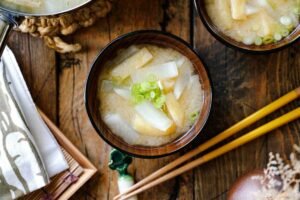
Ingredients and Preparation:
Ingredients:
- Miso Paste: The big name thing, crafted from fermented soybeans, rice, or barley.
- Dashi: A traditional Japanese broth made from kombu (kelp) and katsuobushi (bonito flakes), although versions can consist of shiitake mushrooms and anchovies.
- Tofu: Soft or corporation tofu cubes upload texture and protein.
- Seaweed: Wakame seaweed rehydrates inside the soup, imparting a diffused marine taste.
- Green Onions: Chopped inexperienced onions add freshness and a slight bite.
Preparation:
- Making Dashi: Start by making dashi. Soak kombu in water and then deliver it to a simmer. Remove the kombu earlier than it boils. Add bonito flakes and simmer for a few minutes, then strain the broth.
- Adding Ingredients: Bring the dashi to a moderate simmer. Add rehydrated wakame seaweed and tofu cubes.
- Miso Paste: Dissolve miso paste in a small quantity of hot dashi in a separate bowl, then upload it once more into the pot. Ensure the soup does no longer boil after consisting of the miso to hold its flavor and probiotics.
- Final Touches: Add chopped green onions absolutely before serving.
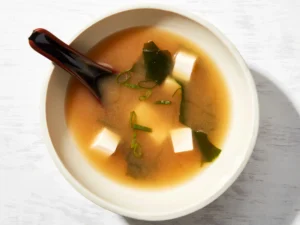
Nutritional Benefits:
Miso soup isn’t always most effective delicious however additionally tremendously nutritious. Miso paste is wealthy in important minerals, vitamins (which incorporates B nutrients), and protein. The fermentation manner produces beneficial probiotics that resource in digestion and manual gut health. Dashi crafted from kombu affords iodine and different trace minerals, whilst tofu offers a source of plant-based protein. Seaweed offers fiber and further vitamins, making miso soup a nicely-rounded dish.
Cultural Significance:
Miso soup is a sort of ultimate comfort, this food-full shrug that anyone can put on at home in Japan. It is a part of traditional Japanese brekkie with rice, fish and pickles. As lunch and dinner are always cold, miso soup goes with those two meals nicely as well so that I have one hot savory component to pair with the other dishes. Miso soup is a symbol of Japanese daily life and hospitality, with its preparation going back centuries.
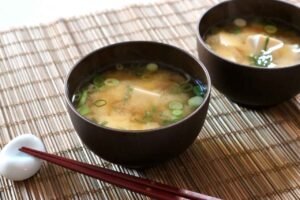
Variations and Modern Twists:
Traditional miso soup recipe is still considered one of the best kind, and you would discover as many assortments according to regional variations or modern fusion. In some variations, other vegetables such as daikon radish, cabbage or shiitake can be used. Some may use red miso (akamiso), white (shiromiso), or mixed three types of taste and excitement levels. It is kneaded in a pan resembling an Indian subzi, sprinkled with ingredients like clams and shrimp or it can be topped with even the most unconventional toppings, cheese for instance by chefs around the world giving its own twist to the fusio concept.
Facts About Miso Soup:
- Centuries Old Tradition: Miso soup has been a part of culinary heritage, for more, than 1,300 years originating from China and later adopted by Buddhist monks in Japan.
- Miso Varieties: The crafting of miso soup involves the use of types of miso each contributing flavors. Common varieties include miso (shiromiso) known for its sweetness, red miso (akamiso) with a robust and salty taste and mixed miso (awase miso).
- Nutritional Value: Miso soup is a powerhouse. Packed with protein, vitamins and minerals miso paste also offers probiotics that promote health. Additionally this savory broth is a calorie and low fat option.
- Probiotic Power: During fermentation, miso creates wide ranges of beneficial bacteria that can aid in digestion and lead to good stomach health. On the other hand, this need to preserve the probiotics shows that the addition of miso paste to a soup should only be during the last part of cooking.
- Dashi Base: Traditional miso soup stock, dashi, is made of kombu, or kelp, and katsuobushi, or bonito flakes. This stock is used as the background for quite a number of Japanese recipes and offers an extremely rich umami taste.
- Versatile Ingredients: Tofu and wakame seaweed represent the traditional ingredients used to make miso soup. However, this most basic combination has numerous variations. Mushrooms, clams, potatoes, carrots, and even pork can be added to change the flavor or texture.
- Seasonal Variations: Depending on the season, miso soup ingredients could change in contemporary Japan. In the spring, fresh vegetables would be used, including spinach and bamboo shoots, and in the winter, root vegetables and mushrooms.
- Miso soup in meals: As part of a traditional Japanese meal, miso soup is not served as a main dish but as an accompaniment. It usually comes with rice, pickles, and fish or meat.
- Daily ritual: For most Japanese families, miso soup is, in itself, a sort of daily ritual. Very often, it forms part of the breakfast menu, where it helps warm up and revitalize the body for the day’s activities.
- Cultural Symbol: Miso soup represents Japanese comfort food—family and warmth. It is, for most Japanese people, a dish one learns to cook as an initial recipe when one is young.
- Instant Versions: With its spread and convenience, instant miso soup packets abound. These mostly include dried miso paste with freeze-dried ingredients inside that rehydrate when one adds hot water.
- Misohitō Overseas: Due to the fact that it is simple and full of flavor, miso soup has gained worldwide popularity; therefore, it is included in most Japanese restaurants’ menus indiscriminately across the globe. It is a dish for those who are getting started with Japanese cuisine.
- Nutrient-Dense: The composition of miso soup is rich in a good balance of macronutrients, with carbohydrates from miso, protein from tofu, and vitamins and minerals from seaweed and vegetables.
- Flavor Enhancer: The umami taste in miso soup is derived both from the paste itself and also in the dashi broth that normally comes with it, hence enhancing other food when taken together.
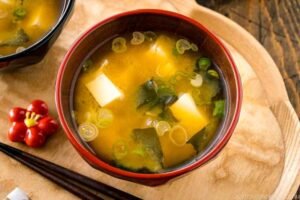
FAQs about Miso Soup:
1. What is Miso Soup?
- Miso soup is one of the typical Japanese soups obtained from the combination of dashi broth and miso paste. Tofu Worcestershire sauce, green onions, and for the sushi, there is wakame.
2. What is Miso Paste?
- Miso paste is a paste made from fermented soybean and it has many types such as white miso, red miso, and mixed miso. It provides some depth of flavor, quite savory to the soup.
3. What is Dashi?
- Dashi soup is a very basic Japanese soup stock prepared with kombu (kelp) and katsuobushi (bonito flakes). It is one of the major components and is used in virtually almost all categories of the Japanese foods such as miso soup.
4. It is quite simple to prepare Miso Soup and below are the steps that can be followed:
- When making miso soup, you first prepare dashi broth.
Both statements and the corresponding actions are consistent with the targeted item. Introduce bean curd and seaweed; the miso paste is mixed with a little hot soup before being added into the soup. Do not let soup boil after adding miso as it destroys the soup’s flavor and destroys the probiotics.
5. Is Miso Soup healthy?
- Yes, miso soup is very healthy. It is helpful because it has few calories, much protein and necessary vitamin and minerals. Miso paste contains loads of probiotic compounds which can be very useful in enhancing digestion of foods in the digestive tract.
6. Can it be prepared as a vegetarian soup or a vegan soup?
- Yes, depending on the bonito granules used, a vegetarian or vegan miso soup can be made substituting the dashi broth used in place of the bonito dashi broth. Kombu and dried shiitake mushroom dashi are popular standard substitutes.
7. What are the possible Subtypes of Miso Paste?
- Yes, there is a whole range of miso paste kinds, starting with white miso paste, which has a sweet and mild taste, and up to red miso paste which is extremely salty; and mixed one, made of both types. It is modest to note that each type comes with its own taste of preferences.
8. In a way yes basically the process is you take broths and boil it, add seasonings and fishcake other ingredients are those you can add in the actual be prepared soup itself.
- Absolutely! The primary things that are used are tofu and seaweed; however, one can use mushrooms, carrots, potatoes, clams, shrimp, and even spinach and other greens as ingredients modify the type of dish being made.
9. It’s concerning to know the right way in which Miso Paste should be stored.
- Miso paste should be kept in refrigerator and the container should be tightly closed. Depending on the ingredients used to make it, it can take up to a few months before the product goes bad, although most Sugo is recommended for consumption within a year.
10. Is Miso Soup gluten-free?
- Thus, an authentic version of the miso soup is gluten-free, provided one uses gluten-free miso paste and serves it with dashi. Nevertheless, some miso pastes may contain barley or any other grain, thus, the use of labels should be complied to avoid using miso paste containing gluten.
11. On preparation, may I prepare Miso Soup ahead or should it be prepared immediately before serving?
- It is recommended that miso soup is prepared fresh; however, the dashi and other ingredients can be prepared beforehand. When preparing the soup, do not add miso paste early to retain the paste’s taste and active bacteria.
12. Why does the Miso Soup not boil once one adds the Miso paste?
- One has to ensure that they do not boil the miso soup after adding the paste for, it destroys the good bacteria or probiotics and changes the taste of the soup. Ideally, the miso should be mixed when the broth is hot but not boiling as boiling water affects matters in the miso.
13. What is the taste or flavor of Miso Soup?
- It is a soup that is made from fermented soybean paste called miso paste which adds that pleasant and savory umami flavor that is both slightly salty and sweet. The dashi provides a slightly sea-food like taste from the kelp and the bonito flakes.
14. May I use instant Miso Soup it will do since I am a little pressed for time here.
- Yes, instant miso soup packets are easy to find in markets and are so packaged to ease their use. Usually it is packed with dried miso paste as well as other freeze-dried components which when are immersed in hot water they expand.
15. Is Miso Soup fit to be taken in the morning, specifically during breakfast time?
- Today miso soup is an obligatory dish in a ‘Kyoto style’ breakfast meal and is a small serving of rice, grilled fish and pickles. It gives a healthy and warm meal for the day.
Conclusion:
Miso soup is perhaps one of the most famous soups that never goes out of fashion when it comes to Japanese food. The combination of such basic ingredients makes it possible to obtain a balanced soup meant to fill the tummy. From a cup of traditional Japanese breakfast or an exotic dish across the world, miso soup will remain to spoon feed many more happy tummies. Its long history, heritage and a possible debate on its deliciousness makes it essential, to anyone intending to taste Japanese cuisine.

